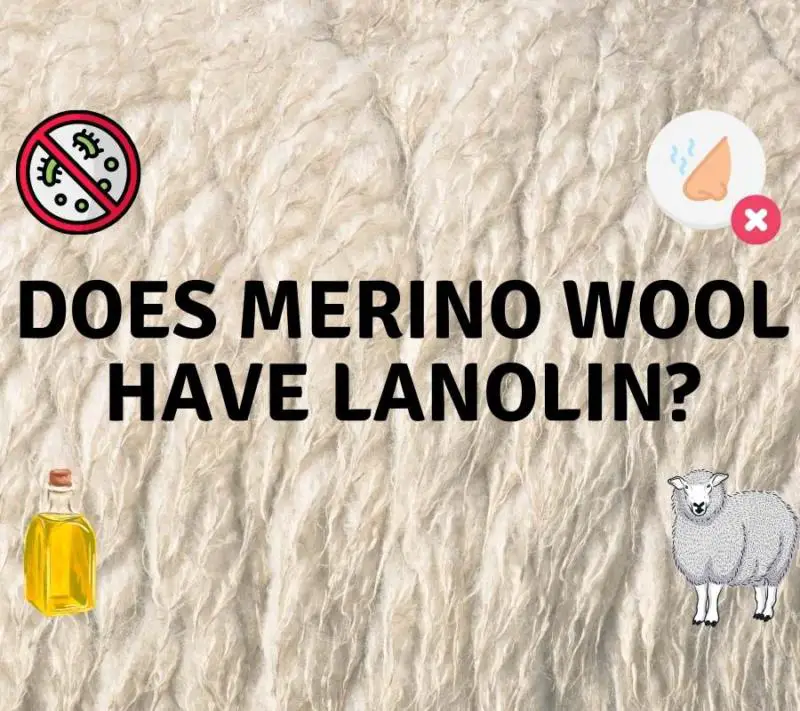Lanolin is the grease that is always present in a sheep’s wool and has many amazing properties.
Merino wool comes from a strain of Merino sheep bred for its wool, and the average Merino wool is usually less than 20 microns, which classifies it as “fine” wool.
Lanolin is essentially what gives merino sheep’s wool many of its unique capabilities like moisture-wicking, odor resistance, and softness – but does merino wool garments contain any residual lanolin after processing?
Yes, but not much! While raw merino wool contains up to 25% of its weight in lanolin, most processed merino garments that you wear will contain less than 1% unaltered lanolin. This amount is enough to provide the beneficial properties of merino wool, while not feeling oily against your skin.
The sebaceous glands of the sheep (or other woolen animals) secrete lanolin, which keeps their wool soft, moisturized, and stops the sheep from being sunburnt by conditioning the wool.
Lanolin has similar properties to the sebum that’s secreted in human skin and similar waxy oils are also found in the wool of many other animals.
To extract lanolin for commercial use, raw wool is treated with a soap solution to extract lanolin.
The extracted lanolin is then used in other cosmetic products such as creams and lotions or even to reapply onto woolen garments to improve their natural features.

What is the Function of Lanolin in Merino Wool?
Merino is a versatile natural fiber! The harsh conditions that most Merino wool sheep live in will surprise you. They graze in rocky, short grass, sometimes rainy and cold areas, or dry areas where the nighttime temperature falls below zero.
If the conditions are right, the farmer will grow the finest merino wool and attract the top prices from the top outdoor brands or leading Italian suit makers.
Lanolin keeps the wool “lubricated”, odor-resistant, and able to transport water/sweat.
Lanolin is known as an occlusive moisturizer, making it an ideal barrier cream for the skin. The same is true for the lanolin naturally present in merino wool.
Lanolin makes sheep waterproof and is essentially where the “smell of sheep” comes from.
Merino wool is very popular for outdoor Winter clothing, and 100%superfine Merino wool is preferred.
The more your woolen garment smells of sheep, the more lanolin it is likely to contain.
So while your grandpa’s thick woolen sweater is likely to contain much more lanolin (as you can properly smell!) than modern merino wool garments, there are still traces left in finer wool garments.
Perhaps the most important function of lanolin is its water repellent properties that allow the efficient transportation of sweat away from the body and prevents the wool fibers from collapsing when wet.
This is because the lanolin traps air between the fibers allowing good insulation to occur. This is part of the reason why lanolin oil has natural antibacterial properties, useful in preventing body odors.
As for the sheep, even a small amount of lanolin in the wool fabric allows the garment to provide the proper breathability and moisture transport so that it will be warm in winter and cool in summer.

How Do You Preserve the Lanolin in Merino Wool garments?
If you want to keep the favorable properties of your wool intact. You need to be careful when washing merino wool.
Lanolin is a fat so it will be dissolved more in water if there is a high concentration of soap and the temperature is high.
Therefore, to prevent the lanolin from dissolving, you need to use cold water and minimal amounts of soap. And never use enzymatic detergents as they will also degrade the wool fibers themselves.
Essentially following the outlines that are also appropriate if you want to avoid shrinkage of your merino garment. I wrote a detailed post on that topic here.
Can You Add Lanolin Back to Merino Wool?
The merino wool fabric you wear contains from nearly 0% to around 2% lanolin. The exact content depends on its intended use and pre-treatment.
As you wear and tear your merino wool clothes, and especially when you wash them, the lanolin levels will drop.
Using the right methods, lanolin can be added back into your old merino garment, and there are quite a few reasons why you would want to do this, including:
- To help make outerwear more resistant to rain.
- Reduce fiber shedding.
- To increase odor resistance.
- To help with moisture transport.
- It feels nicer against the skin.
To do this you will need half a teaspoon of lanolin oil per pound of wool mixed in half a cup of hot water until melted.
You can buy lanolin oil in most pharmacies or online for example on amazon.
Some laundry soaps also come with lanolin to help limit the loss of lanolin when washing your wool.
Submerge your wool in the water and soak for 20 minutes this allows the wool to absorb the lanolin. Gently drain the wool jumper and dry it on a flat surface, never wring it out.
Can Lanolin be Problematic?
Apart from the slight smell of wet sheep, there is so little lanolin in modern merino wool clothing that it is unlikely to cause any adverse reactions.
However, lanolin is generally safe and is also used as a barrier cream for babies, which would not be the case if it was not harmless in the majority of cases.
It is well known that if traditional wool is worn in direct skin contact, it will itch, and sometimes this itch is mistaken for allergy towards lanolin but is actually caused by the larger wool fibers in coarse wool types.

True lanolin allergy is surprisingly rare, and people who claim to be allergic to lanolin often prove to be hypersensitive to the touch of wool or other chemicals used in the processing of the wool.
Chemicals such as formaldehyde and chromium may cause itchy red patches on the skin if the garment has not yet been washed properly.
Because merino wool has a small diameter (less than 25 microns), it bents and curls up more easily, which makes it feel softer and less itchy to touch. Lanolin actually protects this property by protecting these micro hairs against degradation.
How to Remove Lanolin from Merino Wool garment
If you suspect a sensitivity to lanolin or just don’t like the smell or feel of the oily garment, you may wash any wool type repeatedly to get rid of residual lanolin.
Most people that are sensitive towards wool just don’t wear it right next to their skin as it may cause rashes for them.
However, if you are in doubt of whether lanolin is causing any negative effects for you, you may just use a thorough washing procedure to remove the traces of lanolin that may be present in your woolen garment.
The lanolin oil can be removed from the wool by washing it with a higher amount of soap than you would normally use, a longer soaking time, and a slightly higher temperature. But not too high a temperature, as it will otherwise shrink!

This can be done in a washing machine or if you only have a small batch of wool this is how it is done:
- Fill your sink with warm water (up to 120F or 50 degrees Celsius) and add 2 tablespoons of liquid wool shampoo soap (or other mild soap without enzymes).
- Gently immerse the wool in the sink, move it around with your hands to make sure it is fully soaked.
- Soak it for one to two hours and rinse twice with lukewarm water.
- Dry it by laying it flat on a towel. Don’t twist it to get excess liquid out, just air dry it.
A day or two later, your wool will be dry soft, and clean.
If you wonder about the lanolin content of other wool types such as cashmere, alpaca, and musk ox, I have written a separate article about the lanolin content of different wool types here.




